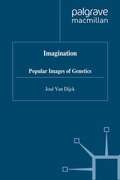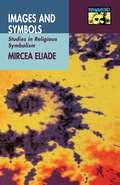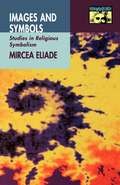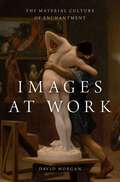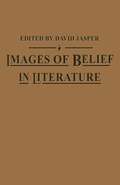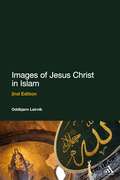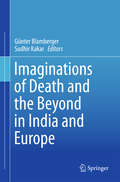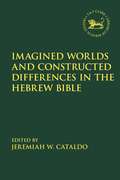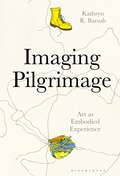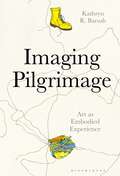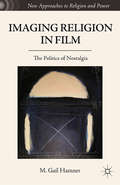- Table View
- List View
The Image, the Depths and the Surface: Multivalent Approaches to Biblical Study (The Library of Hebrew Bible/Old Testament Studies)
by Susan GillinghamThe purpose of this book is to illustrate that reading is a subjective process which results in multivalent interpretations. This is the case whether one looks at a text in its historical contexts (the diachronic approach) or its literary contexts (the synchronic approach). Three representative texts are chosen from the Law (Genesis 2-3), the Writings (Isaiah 23) and the Prophets (Amos 5), and each is read first by way of historical analysis and then by literary analysis. Each text provides a number of variant interpretations and raises the question--is any one interpretation superior? What criteria do we use to measure this? Or is there value in the complementary nature of many approaches and many results?
Image, Word and God in the Early Christian Centuries (Studies in Philosophy and Theology in Late Antiquity)
by Mark EdwardsChristianity proclaims Christ and the incarnate word of God; the Bible is described as the Word of God in both Jewish and Christian tradition. Are these usages merely homonymous, or would the ancients have recognized a more intimate relation between the word incarnate and the word proclaimed? This book investigates the concept of logos in pagan, Jewish and Christian thought, with a view to elucidating the polyphonic functions which the word acquired when used in theological discourse. Edwards presents a survey of theological applications of the term Logos in Greek, Jewish and Christian thought from Plato to Augustine and Proclus. Special focus is placed on: the relation of words to images in representation of divine realm, the relation between the logos within (reason) and the logos without (speech) both in linguistics and in Christology, the relation between the incarnate Word and the written text, and the place of reason in the interpretation of revelation. Bringing together materials which are rarely synthesized in modern study, this book shows how Greek and biblical thought part company in their appraisal of the capacity of reason to grasp the nature of God, and how in consequence verbal revelation plays a more significant role in biblical teaching. Edwards shows how this entailed the rejection of images in Jewish and Christian thought, and how the manifestation in flesh of Christ as the living word of God compelled the church to reconsider both the relation of word to image and the interplay between the logos within and the written logos in the formulation of Christian doctrine.
Image, Word and God in the Early Christian Centuries (Studies in Philosophy and Theology in Late Antiquity)
by Mark EdwardsChristianity proclaims Christ and the incarnate word of God; the Bible is described as the Word of God in both Jewish and Christian tradition. Are these usages merely homonymous, or would the ancients have recognized a more intimate relation between the word incarnate and the word proclaimed? This book investigates the concept of logos in pagan, Jewish and Christian thought, with a view to elucidating the polyphonic functions which the word acquired when used in theological discourse. Edwards presents a survey of theological applications of the term Logos in Greek, Jewish and Christian thought from Plato to Augustine and Proclus. Special focus is placed on: the relation of words to images in representation of divine realm, the relation between the logos within (reason) and the logos without (speech) both in linguistics and in Christology, the relation between the incarnate Word and the written text, and the place of reason in the interpretation of revelation. Bringing together materials which are rarely synthesized in modern study, this book shows how Greek and biblical thought part company in their appraisal of the capacity of reason to grasp the nature of God, and how in consequence verbal revelation plays a more significant role in biblical teaching. Edwards shows how this entailed the rejection of images in Jewish and Christian thought, and how the manifestation in flesh of Christ as the living word of God compelled the church to reconsider both the relation of word to image and the interplay between the logos within and the written logos in the formulation of Christian doctrine.
Imagenation: Popular Images of Genetics
by José Van DijckGenetics seems more popular then ever. DNA technology not only sustains large areas of biomedicine and business, but also prevails in social and legal practices and takes root in cultural products. Since the late 1950s, the public image of genetics metamorphosed from a suspect branch of research into a thriving, well-funded field of biomedicine. Images and imaginations have played a crucial role in the popularization of genetic knowledge. The media played up images of engineered bugs, scientists promoted images of selfish genes and science fiction writers infested the imagination with stories of cloned monsters. Imag e nation examines the role of science, journalism and fiction in the popularization of genetics.
Images and Symbols: Studies in Religious Symbolism (Bollingen Series #684)
by Mircea EliadeMircea Eliade--one of the most renowned expositors of the psychology of religion, mythology, and magic--shows that myth and symbol constitute a mode of thought that not only came before that of discursive and logical reasoning, but is still an essential function of human consciousness. He describes and analyzes some of the most powerful and ubiquitous symbols that have ruled the mythological thinking of East and West in many times and at many levels of cultural development.
Images and Symbols: Studies in Religious Symbolism
by Mircea Eliade Philip MairetMircea Eliade--one of the most renowned expositors of the psychology of religion, mythology, and magic--shows that myth and symbol constitute a mode of thought that not only came before that of discursive and logical reasoning, but is still an essential function of human consciousness. He describes and analyzes some of the most powerful and ubiquitous symbols that have ruled the mythological thinking of East and West in many times and at many levels of cultural development.
Images at Work: The Material Culture of Enchantment
by David MorganImages can be studied in many ways--as symbols, displays of artistic genius, adjuncts to texts, or naturally occurring phenomena like reflections and dreams. Each of these approaches is justified by the nature of the image in question as well as the way viewers engage with it. But images are often something more when they perform in ways that exhibit a capacity to act independent of human will. Images come alive--they move us to action, calm us, reveal the power of the divine, change the world around us. In these instances, we need an alternative model for exploring what is at work, one that recognizes the presence of images as objects that act on us. Building on his previous innovative work in visual and religious studies, David Morgan creates a new framework for understanding how the human mind can be enchanted by images in Images at Work. In carefully crafted arguments, Morgan proposes that images are special kinds of objects, fashioned and recognized by human beings for their capacity to engage us. From there, he demonstrates that enchantment, as described, is not a violation of cosmic order, but a very natural way that the mind animates the world around it. His groundbreaking study outlines the deeply embodied process by which humans create culture by endowing places, things, and images with power and agency. These various agents--human and non-human, material, geographic, and spiritual--become nodes in the web of relationships, thus giving meaning to images and to human life. Marrying network theory with cutting-edge work in visual studies, and connecting the visual and bodily technologies employed by the ancient Greeks and Romans to secular icons like Che Guevara, Abraham Lincoln, and Mao, Images at Work will be transformative for those curious about why images seem to have a power of us in ways we can't always describe.
Images at Work: The Material Culture of Enchantment
by David MorganImages can be studied in many ways--as symbols, displays of artistic genius, adjuncts to texts, or naturally occurring phenomena like reflections and dreams. Each of these approaches is justified by the nature of the image in question as well as the way viewers engage with it. But images are often something more when they perform in ways that exhibit a capacity to act independent of human will. Images come alive--they move us to action, calm us, reveal the power of the divine, change the world around us. In these instances, we need an alternative model for exploring what is at work, one that recognizes the presence of images as objects that act on us. Building on his previous innovative work in visual and religious studies, David Morgan creates a new framework for understanding how the human mind can be enchanted by images in Images at Work. In carefully crafted arguments, Morgan proposes that images are special kinds of objects, fashioned and recognized by human beings for their capacity to engage us. From there, he demonstrates that enchantment, as described, is not a violation of cosmic order, but a very natural way that the mind animates the world around it. His groundbreaking study outlines the deeply embodied process by which humans create culture by endowing places, things, and images with power and agency. These various agents--human and non-human, material, geographic, and spiritual--become nodes in the web of relationships, thus giving meaning to images and to human life. Marrying network theory with cutting-edge work in visual studies, and connecting the visual and bodily technologies employed by the ancient Greeks and Romans to secular icons like Che Guevara, Abraham Lincoln, and Mao, Images at Work will be transformative for those curious about why images seem to have a power of us in ways we can't always describe.
Images of Empire (The Library of Hebrew Bible/Old Testament Studies)
by Loveday AlexanderAt the Images of Empire colloquium held in Sheffield in 1990, an international team of scholars met to explore some of the conflicting images generated by the Roman Empire. The articles reflect interests as diverse as those of the scholars themselves: Roman history and archaeology, Jewish Studies, Dead Sea Scrolls, New Testament and Patristics are all represented. All are focused on a single theme, the importance of which is increasingly recognized, not only for the historian, but for everyone interested in the political complexities of our post-imperial world.
Images of Jesus Christ in Islam: 2nd Edition
by Oddbjørn LeirvikImages of Jesus Christ in Islam 2nd Edition provides a general introduction to the question of Jesus Christ in Islam and a dialogical discussion of this issues' importance for Christian-Muslim relations. Its originality lies in its comprehensive presentation of relevant sources and research and its discussion of Islamic images of Christ in the wider context of Muslim-Christian relations. Oddbjørn Leirvik provides a comprehensive introduction to a breadth of Muslim traditions through an examination of interpretations of Jesus throughout history, whilst also examining historic tensions between Islam and Christianity. This book's distinctive contribution lies in its dialogical perspective in the perennial area of interest of Islam and Christian-Muslim relations.
Images of Jesus Christ in Islam: 2nd Edition
by Oddbjørn LeirvikImages of Jesus Christ in Islam 2nd Edition provides a general introduction to the question of Jesus Christ in Islam and a dialogical discussion of this issues' importance for Christian-Muslim relations. Its originality lies in its comprehensive presentation of relevant sources and research and its discussion of Islamic images of Christ in the wider context of Muslim-Christian relations. Oddbjørn Leirvik provides a comprehensive introduction to a breadth of Muslim traditions through an examination of interpretations of Jesus throughout history, whilst also examining historic tensions between Islam and Christianity. This book's distinctive contribution lies in its dialogical perspective in the perennial area of interest of Islam and Christian-Muslim relations.
Imagination: Enhancing the Powers of Thinking
by Rudolf SteinerRudolf Steiner differentiated clearly between the spiritual concept of Imagination and our everyday understanding of the word. As living, pictorial thinking, Imagination is a primary aspect of the contemporary path of inner schooling – the first of three levels of initiate knowledge and cognition. Imagination leads us into a world of flowing, living pictures: a realm of soul and spirit in which everything is in continual movement.This anthology offers a survey of the diverse aspects of Imagination and imaginative cognition. As the thematically re-ordered texts reveal, Rudolf Steiner’s spiritual philosophy – anthroposophy – is itself often pictorial and imaginative in nature. Many of its fundamental concepts, such as the evolution of the world and the human being, were formulated by Steiner in vivid, living pictures. However, whilst imaginative perception leads us to the threshold of the spiritual world, we can also fall prey there to illusions, visions and hallucinations.This volume, expertly assembled by Edward de Boer, draws on the entirety of Rudolf Steiner’s collected works – from his earliest writings to passages from his many lectures. It is conceived as a stimulus to readers to practise, deepen and extend their own imaginative consciousness. Steiner’s commentary on ‘exemplary Imaginations’, in particular, encourages further study, contemplation and schooling of our own pictorial thinking.Chapters include ‘Imagination as Supersensible Cognition’; ‘The Rosicrucian Path of Schooling’; ‘Exercises to Develop Imagination’; ‘Understanding Imagination Through Inspiration and Intuition’; ‘Illusions, Hallucinations and Visions’; ‘Imaginative Perception as the Threshold to the Etheric World’; ‘Goethe’s Worldview’ and ‘Exemplary Imaginations’ (including commentary on ‘The Fairy-tale of the Green Snake and the Beautiful Lily’, The Mystery Plays; The Great Initiates; the ‘Apocalyptic Seals’; The Chymical Wedding of Christian Rosenkreutz and the ‘Michael Imagination’).
Imaginations of Death and the Beyond in India and Europe
by Günter Blamberger Sudhir KakarThis volume explores current images of afterlife/afterdeath and the presence of the dead in the imaginations of the living in Indian and European traditions. Specifically, it focuses on the deepest and most fundamental uncertainty of human existence---the awareness of human mortality, on which depends any assignment of meaning to earthly existence as also to notions of worldly and otherworldly salvation. This central idea is addressed in the literature, arts, audiovisual media and other cultural artefacts of the two traditions. The chapters are based on two main assumptions: First, that one cannot report on the direct experience of death; so it is only possible to speak allegorically of it. Second, in contemporary Western societies, marked by structural atheism, people look at literature, the arts and mass media to study their depiction and reading of traditionally religious questions of disease, death and the Beyond. This is in contrast to Asian civilizations whose preoccupation with death and Beyond is persistent and perhaps central to the civilizations’ highest thought. The chapters cover a wide spectrum of disciplinary approaches, from psychoanalysis to religious, anthropological, literary and film studies, from sociology and philosophy to art history, and address issues of unsettling power: comforting illusions of afterlife; the relations between afterlife and fertility; visions of technological immortalization of mankind; the problem of thinking about death after the “death of God”; socialist utopias of bodily immortality; fear of Hell and punishment; different concepts in relating the living and the dead; near-death experiences; and cultural practices of spiritualism, occultism and suicide.
The Imaginative Life Tableau: The spiritually-percieved story of our life between birth and death. Meditative knowledge out of childhood forces.
by Rudolf SteinerMany will be familiar with the notion that a person at the point of death sees their life flash before them. Rudolf Steiner describes that when the spiritual bodies separate from the physical body, the etheric body of the dying person is revealed, giving a panoramic overview of their earthly life. This etheric body contains everything we have experienced in our consciousness and kept in memory. The etheric not only generates and sustains all life, but encompasses the life forces out of which we shape our existence. Although the revelation of the life tableau belongs to the early period after death, it can also emerge as a result of meditation. Rudolf Steiner speaks of this – through the first level of spiritual experience known as ‘imagination’ – as a conscious self-perception of the soul, taking place in the world of images. Here we are confronted with the harrowing knowledge of our doppelgänger – but we also experience the cosmic forces of childhood that are present in all our life processes. These same forces are described in psychology as the ‘inner child’. In this highly-original anthology of Steiner’s work we are led to a therapeutic, meditative approach that – through working with the imaginative life tableau – can strengthen and heal body, soul and spirit. Chapters include: ‘Experiencing the Inner Child as the Starting Point for a New Philosophy’; ‘Experiencing Life before Birth’; ‘Pain and Sadness When Reliving the Life Tableau’; ‘Intensive Backward Thinking’; ‘Feelings of Happiness When Experiencing the Life Tableau’; ‘Re-experiencing the Inner Child’; ‘Through the Forces of Childhood to the Higher Self and the Christ Experience’.
Imagined Communities in Greece and Turkey: Trauma and the Population Exchanges under Atat?rk (International Library of Twentieth Century History)
by Emine Yesim BedlekIn 1923 the Turkish government, under its new leader Kemal Atatürk, signed a renegotiated Balkan Wars treaty with the major powers of the day and Greece. This treaty provided for the forced exchange of 1.3 million Christians from Anatolia to Greece, in return for 30,000 Greek Muslims. The mass migration that ensued was a humanitarian catastrophe – of the 1.3 million Christians relocated it is estimated only 150,000 were successfully integrated into the Greek state. Furthermore, because the treaty was ethnicity-blind, tens of thousands of Muslim Greeks (ethnically and linguistically) were forced into Turkey against their will. Both the Greek and Turkish leadership saw this exchange as crucial to the state-strengthening projects both powers were engaged in after the First World War. Here, Emine Bedlek approaches this enormous shift in national thinking through literary texts – addressing the themes of loss, identity, memory and trauma which both populations experienced. The result is a new understanding of the tensions between religious and ethnic identity in modern Turkey
Imagined Worlds and Constructed Differences in the Hebrew Bible (The Library of Hebrew Bible/Old Testament Studies)
by Jeremiah W. CataldoThe purpose of this volume is twofold: to introduce readers to the study of cultural memory and identity in relation to the Hebrew Bible, and to set up strategies for connecting studies of the historical contexts and literature of the Bible to parallel issues in the present day. The volume questions how we can better understand the divide between insider and outsider and the powerful impact of prejudice as a basis for preserving differences between "us" and "them"? In turn the contributors question how such frameworks shape a community's self-perception, its economics and politics. Guided by the general framework of Anderson's theory of nationalism and the outsider, such issues are explored in related ways throughout each of the contributions. Each contribution focuses on social, economic, or political issues that have significantly shaped or influenced dominant elements of cultural memory and the construction of identity in the biblical texts. Together the contributions present a larger proposal: the broad contours of memory and identity in the Bible are the products of a collective desire to reshape the social-political world.
Imagined Worlds and Constructed Differences in the Hebrew Bible (The Library of Hebrew Bible/Old Testament Studies #677)
by Jeremiah W. CataldoThe purpose of this volume is twofold: to introduce readers to the study of cultural memory and identity in relation to the Hebrew Bible, and to set up strategies for connecting studies of the historical contexts and literature of the Bible to parallel issues in the present day. The volume questions how we can better understand the divide between insider and outsider and the powerful impact of prejudice as a basis for preserving differences between "us" and "them"? In turn the contributors question how such frameworks shape a community's self-perception, its economics and politics. Guided by the general framework of Anderson's theory of nationalism and the outsider, such issues are explored in related ways throughout each of the contributions. Each contribution focuses on social, economic, or political issues that have significantly shaped or influenced dominant elements of cultural memory and the construction of identity in the biblical texts. Together the contributions present a larger proposal: the broad contours of memory and identity in the Bible are the products of a collective desire to reshape the social-political world.
Imaging Pilgrimage: Art as Embodied Experience
by Kathryn BarushWhile place-based pilgrimage is an embodied practice, can it be experienced in its fullness through built environments,assemblages of souvenirs, and music? Imaging Pilgrimage explores contemporary art that is created after a pilgrimage and intended to act as a catalyst for the embodied experience of others. Each chapter focuses on a contemporary artwork that links one landscape to another-from the Spanish Camino to a backyard in the Pacific Northwest, from Lourdes to South Africa, from Jerusalem to England, and from Ecuador to California. The close attention to context and experience allows for popular practices like the making of third-class or "contact" relics to augment conversations about the authenticity or perceived power of a replica or copy; it also challenges the tendency to think of the “original” in hierarchic terms.Imaging Pilgrimage brings various fields into conversation by offering a number of lenses and theoretical approaches (materialist, kinesthetic, haptic, synesthetic) that engage objects as radical sites of encounter, activated through religious and ritual praxis, and negotiated with not just the eyes, but a multiplicity of senses.
Imaging Pilgrimage: Art as Embodied Experience
by Kathryn BarushWhile place-based pilgrimage is an embodied practice, can it be experienced in its fullness through built environments,assemblages of souvenirs, and music? Imaging Pilgrimage explores contemporary art that is created after a pilgrimage and intended to act as a catalyst for the embodied experience of others. Each chapter focuses on a contemporary artwork that links one landscape to another-from the Spanish Camino to a backyard in the Pacific Northwest, from Lourdes to South Africa, from Jerusalem to England, and from Ecuador to California. The close attention to context and experience allows for popular practices like the making of third-class or "contact" relics to augment conversations about the authenticity or perceived power of a replica or copy; it also challenges the tendency to think of the “original” in hierarchic terms.Imaging Pilgrimage brings various fields into conversation by offering a number of lenses and theoretical approaches (materialist, kinesthetic, haptic, synesthetic) that engage objects as radical sites of encounter, activated through religious and ritual praxis, and negotiated with not just the eyes, but a multiplicity of senses.
Imaging Religion in Film: The Politics of Nostalgia (New Approaches to Religion and Power)
by M. Gail HamnerThis book offers a new methodology for examining the ethico-political dimensions of religion and film which foregrounds film's social power both to shape subjectivity and to image contemporary social contradictions and analyses three specific films: Kurosawa's Dersu Uzala ; Kiarostami's Taste of Cherry ; and the Coens' The Man Who Wasn't There .
Imagining a Place for Buddhism: Literary Culture and Religious Community in Tamil-Speaking South India
by Anne E. MoniusWhile Tamil-speaking South India is celebrated for its preservation of Hindu tradition, other religious communities have played a significant role in shaping the region's religious history. Among these non-Hindu communities is that of the Buddhists, who are little-understood because of the scarcity of remnants of Tamil-speaking Buddhist culture. Here, focusing on the two Buddhist texts in Tamil that are complete (a sixth-century poetic narrative and an eleventh-century treatise on grammar and poetics), Monius sheds light on the role of literature and literary culture in the formation, articulation, and evolution of religious identity and community.
Imagining Arab Womanhood: The Cultural Mythology of Veils, Harems, and Belly Dancers in the U.S.
by A. JarmakaniA fascinating demonstration of how U.S. representations of veils, harems, and belly dancers have operated as nostalgic and exotic symbols to help rationalize dominant U.S. narratives about power and progress.
'Imagining' Biblical Worlds: Studies in Spatial, Social and Historical Constructs in Honour of James W. Flanagan (The Library of Hebrew Bible/Old Testament Studies)
by David M. Gunn Paula McNuttThe essays in this volume address the interface between biblical studies, archaeology, sociology and cultural anthropology, celebrating the pioneering work of James Flanagan. In particular, this collection explores various ways in which the real ancient world is constructed by the modern critical reader with the aid of various theoretical and practical tools.The contributors to this volume have all been involved with Flanagan and his projects during his academic career and the essays carry forward the important interdisciplinary agendas he has encouraged. Part One deals with his recent interest in spatiality and Part Two with social and historical constructs.This book in James Flanagan's honour represents a significant statement of research in an area of biblical and historical research that is increasingly important yet surprisingly under-represented.
Imagining Bosnian Muslims in Central Europe: Representations, Transfers and Exchanges (Austrian and Habsburg Studies #32)
by František ŠístekAs a Slavic-speaking religious and ethnic “Other” living just a stone’s throw from the symbolic heart of the continent, the Muslims of Bosnia and Herzegovina have long occupied a liminal space in the European imagination. To a significant degree, the wider representations and perceptions of this population can be traced to the reports of Central European—and especially Habsburg—diplomats, scholars, journalists, tourists, and other observers in the late nineteenth and early twentieth centuries. This volume assembles contributions from historians, anthropologists, political scientists, and literary scholars to examine the political, social, and discursive dimensions of Bosnian Muslims’ encounters with the West since the nineteenth century.


